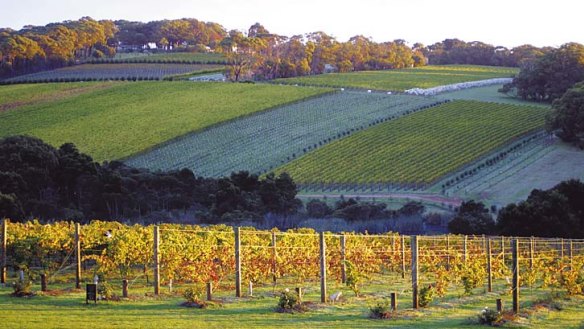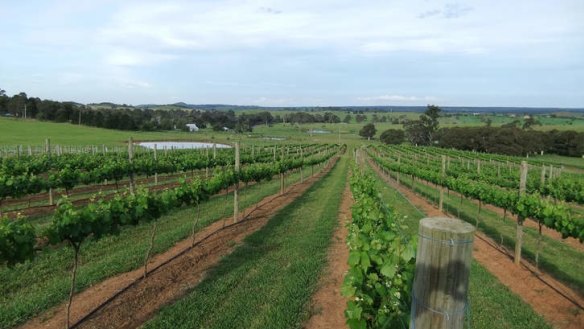Shady operators triumph in the heat
Mornington Peninsula winegrowers are turning over a new leaf - literally - as they face up to global warming.

The first prick of the sun's rays on the skin is soothing. It's warm and welcoming but, as the summer temperature rises, the heat gets warmer and hotter and then "ouch". You've got sunburn.
If you're a wine grape hanging out there on the vine, it's bad news. All that damage done to your skin can become a problem when you are finally picked and turned into wine.
Sunburnt chardonnay, once it reaches the glass, tends to look like it has been dragged through the dirt. It turns brown. Shiraz exposed to way too much sun loses some of its smashing red colour, and riesling ends up with a kerosene flavour that some drinkers used to appreciate but which is now generally acknowledged as a fault.

In 2009, Mornington Peninsula winemakers experienced some of the hottest growing conditions in memory. At Paradigm Hill, co-owner and winemaker George Mihaly watched as the heat burnt, then killed, leaves on his shiraz. He immediately made the decision to drop half of the fruit hanging on the vine.
"I think the result was a very good one," he says.
He ended up with less fruit, which made less wine, but the quality, he says, was high.
Losing those leaves in the heat had thrown the vine out of balance – in viticultural speak, the leaf-to-bunch ratio was out of whack – so the vine failed to ripen all of its fruit, and fruit was dropped.
It's a scene that looks set to be repeated at vintage time in coming years as climate change makes itself more apparent in extreme weather events and a long-term trend towards warmer seasons.
For eight years, Mihaly and 19 of his colleagues on the Mornington Peninsula have been plotting those changes in one of the longest-running research programs in the Australian wine industry.
Every 15 minutes during the growing season (from December to March) of the NV6 clone of the grape, which is at the basis of peninsular pinot production, data is logged (specifically the temperature in the canopy or foliage surrounding the grapes) and after vintage the information is collected and presented in a report accompanied by a tasting of the wines.
What they have discovered has changed the way they grow grapes. They'd like to think it has also improved wine quality.
"It seems so simple," says Yabby Lake viticulturist Keith Harris. The winegrowers now offer their vines sun protection. Leaves on the eastern side of the wines are plucked away from grapes – opening them up to the gentle morning sun – while leaves on the western side are kept for protection against the strong afternoon rays.
Historically, vignerons everywhere pluck leaves away from grapes in the lead-up to harvest to stop shading of their fruit, which can lead to under-ripe fruit being picked, resulting in green, herbaceous wine flavours. The makers now see less herbaceousness in their pinots.
The temperature within the grapevine is monitored to ensure it stays in the desirable zone – for pinot that's 15-28 degrees.
The number of leaves in each bunch is also counted, with the target being an average of 15 mature ones a bunch.
"The leaves, after all, are like the solar panels of the plant," Mihaly says. "They have to assimilate the energy from the sun to pop into the ripening of the fruit and if you don't have enough leaves per bunch of fruit, your fruit isn't going to ripen."
Armed with this information and a host of other data, winemakers now say they feel a little more confident about dealing with what nature might throw their way.
"We weren't wanting to get into a debate about who has caused climate change," Mihaly says.
"But we're having to handle the reality of the climate having evolved into a totally different form for us."
A warmer climate changes the timing of harvest, moving it forward, closer to the heat of summer rather than the cool of autumn. In the 1990s, Mornington Peninsula winemakers generally picked in April. In the 2000s it moved to March.
The annual average temperature across Australian wine regions between now and 2030 is expected to increase between 0.3 and 1.7 degrees. By 2050, the projected increase is 0.4 to 2.6 degrees.
At the back of their minds, many producers will be aware of the landmark 2006 University of Melbourne report that revealed temperate zones for cool-climate varieties (including pinot) could reduce by as much as 40 per cent (allowing for a mid-range of warming) or 60 per cent (under a high warming scenario) by 2050. It's possibly why they continue to contribute towards the $20,000-a-year climate-change study.
The program isn't cheap but, showing the kind of collegiate mentality particular to the wine industry, the group doesn't keep the findings secret but shares them openly with colleagues in other wine regions as well as internationally.
Burgundy producer Domaine David Clark is one of the latest French producers privy to the research.
"There's got to be some judgments about where we are going," Harris says.
"We all talk to each other."
Climate-change pioneers
The Mornington Peninsula vignerons making history.
1. Peninsula Vinecare
2 and 3. Yabby Lake — two vineyards
4. Baillieu Vineyard
5. Paradigm Hill
6. Rahona Valley
7 and 8. Ten Minutes by Tractor — two vineyards
9. Montalto
10. Eldridge Estate
11. Paringa Estate
12. Foxeys Hangout
13. Kooyong
14. Moorooduc
15. Staindl
16. Prancing Horse
17. Crittenden Wines
18. Willow Creek